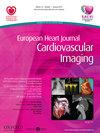Arrhythmogenic cardiomyopathy is characterized by apex-to-base heterogeneity of right ventricular myocardial contractility, stiffness, and mechanical delay: a patient-specific modeling study
引用次数: 0
Abstract
Type of funding sources: Public grant(s) – National budget only. Main funding source(s): NWO-ZonMw, VIDI grant 016.176.340 Dutch Heart Foundation (2015T082) Introduction Arrhythmogenic Cardiomyopathy (AC) is an inherited cardiac disease, characterized by life-threatening ventricular arrhythmias and progressive cardiac dysfunction. Geno-positive subjects with and without symptoms may suffer from sudden cardiac death. Therefore, early disease detection and risk stratification is important. Right ventricular (RV) longitudinal deformation abnormalities in early stages of disease have been shown to be of prognostic value. We propose an imaging-based patient-specific computer modelling approach for non-invasive quantification of regional ventricular tissue abnormalities. Purpose To non-invasively reveal the individual patient’s myocardial tissue substrates underlying the regional RV deformation abnormalities in AC mutation carriers. Methods In 65 individuals carrying a plakophilin-2 or desmoglein-2 mutation and 20 control subjects, regional longitudinal deformation patterns of the RV free wall (RVfw), interventricular septum (IVS) and left ventricular free wall (LVfw) were obtained using speckle-tracking echocardiography (Figure: left). This cohort was subdivided into 3 consecutive clinical stages i.e. subclinical (concealed, n = 18) with no abnormalities, electrical stage (n = 13) with only electrocardiographic abnormalities, and structural stage (n = 34) with both electrical and structural abnormalities defined by the 2010 Task Force AC criteria. We developed and used a patient-specific parameter estimation protocol based on the multi-scale CircAdapt cardiovascular system model to create virtual AC subjects (Figure: middle). Using the individuals’ RVfw, IVS, and LVfw strain patterns as model input, this protocol automatically estimated regional RV and global IVS and LVfw tissue properties, such as myocardial contractility, stiffness, and activation delay. Results The computational model was able to reproduce the regional deformation patterns as measured clinically. Patient-specific parameter estimation results (Figure: right) revealed that clinical AC disease progression is characterized by a decrease in contractility and an increase in stiffness and mechanical delay of the RV myocardial tissue in the basal segment compared to the apex. The subclinical stage subjects showed tissue properties comparable to the control group, including a small apex-to-base heterogeneity in tissue properties. Our patient-specific modelling approach is able to reveal individual myocardial substrates underlying the regional RV deformation abnormalities. Early abnormalities in RV longitudinal strain are most likely caused by increased heterogeneity in local tissue properties, such as an apex-to-base decrease of contractility, increased of myocardial stiffness, and time to peak stress. Abnormalities in tissue properties may be found already in the subclinical stage. In future studies, this artificial intelligence approach will be used to investigate how these abnormalities relate to disease progression and arrhythmogenic risk. Abstract Figure. Characterization of AC Disease Substrate心律失常性心肌病的特征是右心室心肌收缩力、僵硬度和机械延迟的尖基异质性:一项患者特异性模型研究
资金来源类型:公共拨款-仅限国家预算。主要资助来源:NWO-ZonMw, VIDI基金016.176.340荷兰心脏基金会(2015T082)介绍心律失常性心肌病(AC)是一种遗传性心脏疾病,以危及生命的室性心律失常和进行性心功能障碍为特征。有或无症状的基因阳性受试者都可能发生心源性猝死。因此,疾病的早期检测和风险分层是很重要的。右室(RV)纵向变形异常在疾病的早期阶段已被证明是预后价值。我们提出了一种基于成像的患者特异性计算机建模方法,用于非侵入性量化区域性心室组织异常。目的非侵入性地揭示AC突变携带者局部RV变形异常的个体心肌组织底物。方法采用斑点跟踪超声心动图(图左),对65例plakophilin-2或desmoglin -2突变个体和20例对照组进行左室游离壁(RVfw)、室间隔(IVS)和左室游离壁(LVfw)的区域纵向变形(图左)。该队列被细分为3个连续的临床阶段,即无异常的亚临床(隐藏,n = 18),只有心电图异常的电学阶段(n = 13),以及根据2010年工作组AC标准定义的电学和结构异常的结构阶段(n = 34)。我们开发并使用了基于多尺度CircAdapt心血管系统模型的患者特定参数估计协议来创建虚拟AC受试者(图中)。该方案使用个体的RVfw、IVS和LVfw应变模式作为模型输入,自动估计区域RV和全局IVS和LVfw组织特性,如心肌收缩力、刚度和激活延迟。结果该计算模型能较好地再现临床测量的局部变形模式。患者特异性参数估计结果(图右)显示,临床AC疾病进展的特征是与心尖相比,右心室基底段心肌组织收缩性降低、僵硬性增加和机械延迟。亚临床阶段受试者的组织特性与对照组相当,包括组织特性的小顶点到基部异质性。我们的患者特异性建模方法能够揭示局部右心室变形异常的个体心肌底物。右心室纵向应变的早期异常很可能是由局部组织特性的异质性增加引起的,如从顶点到基部收缩力下降,心肌刚度增加,应力峰值时间延长。在亚临床阶段可能已经发现组织特性的异常。在未来的研究中,这种人工智能方法将用于研究这些异常与疾病进展和心律失常风险的关系。抽象的图。AC病底物的表征
本文章由计算机程序翻译,如有差异,请以英文原文为准。
求助全文
约1分钟内获得全文
求助全文

 求助内容:
求助内容: 应助结果提醒方式:
应助结果提醒方式:


